-

DesignsA short survey of zoo architecture and design
By Ned Dodington
Berthold Lubetkin’s 1934 Penguin Pool at the London Zoo. (Photo © ZSL)
-
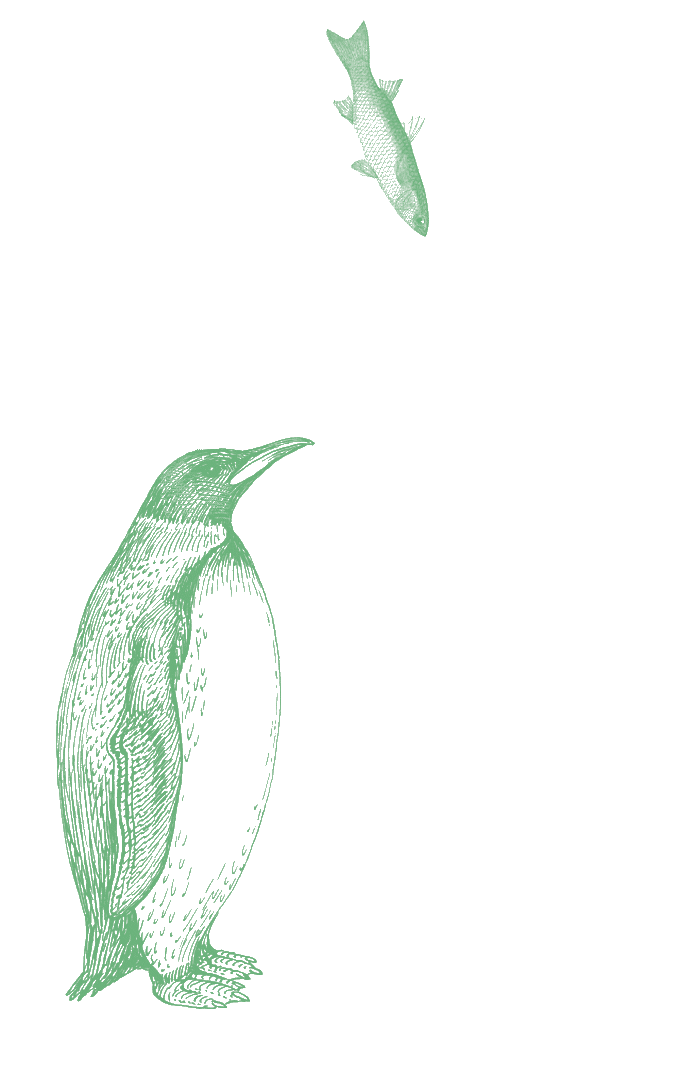
Zoos are strange, wondrous and beguiling institutions. They are instructive and detrimental, culturally specific but universally appealing and architecturally unlike any other constructions. Ned Dodington, founder of expandedenvironment.org and a specialist in design for animals and post-human environments, takes us on a selected tour of zoo design and looks at changing notions of the captive audience.
Zoos are primarily dedicated to the habits and lives of non-human animals, yet the emotions they elicited from us can range from captivation and joy to compassion and sorrow. Beyond the lions, tigers and bears, it’s zoos’ facility to reflect our own humanity that makes them such wondrous places. Many of the lessons learned throughout history in this respect are written on the wall, so to speak, in the landscape, architecture and planning and presentation of zoos – all of which combine to illustrate the human intentions behind the organisation of other animals.
Education, conservation and exoticism: the modern zoo
Collecting exotic animals for exhibition is an ancient practice – there is evidence of a menagerie from 3,500 BC that once existed in the ancient Egyptian capital of Nekhen, or Hierakonpolis – and any history of the zoo would be incomplete without mentioning the story of Noah’s Ark. But today’s zoological gardens, or zoos, trace their first pre-modern incarnations to the aristocratic menageries of the fifteenth, sixteenth and seventeenth centuries in Europe that were purely for exhibition.
By the nineteenth and early twentieth centuries the menageries had given way – in the wake of the Enlightenment and changing attitudes about animal life – to the first modern zoos and zoological conservatories. Among the earliest zoos and zoological parks of this period are the Berlin Zoological Garden in Berlin’s Tiergarten by Martin Lichtenstein and Peter Joseph Lenné (1844), the Bronx Zoological Park in New York by George Lewis Heins and Christopher Grant LaFarge (1899), and Whipsnade Park (1928) in England.
-
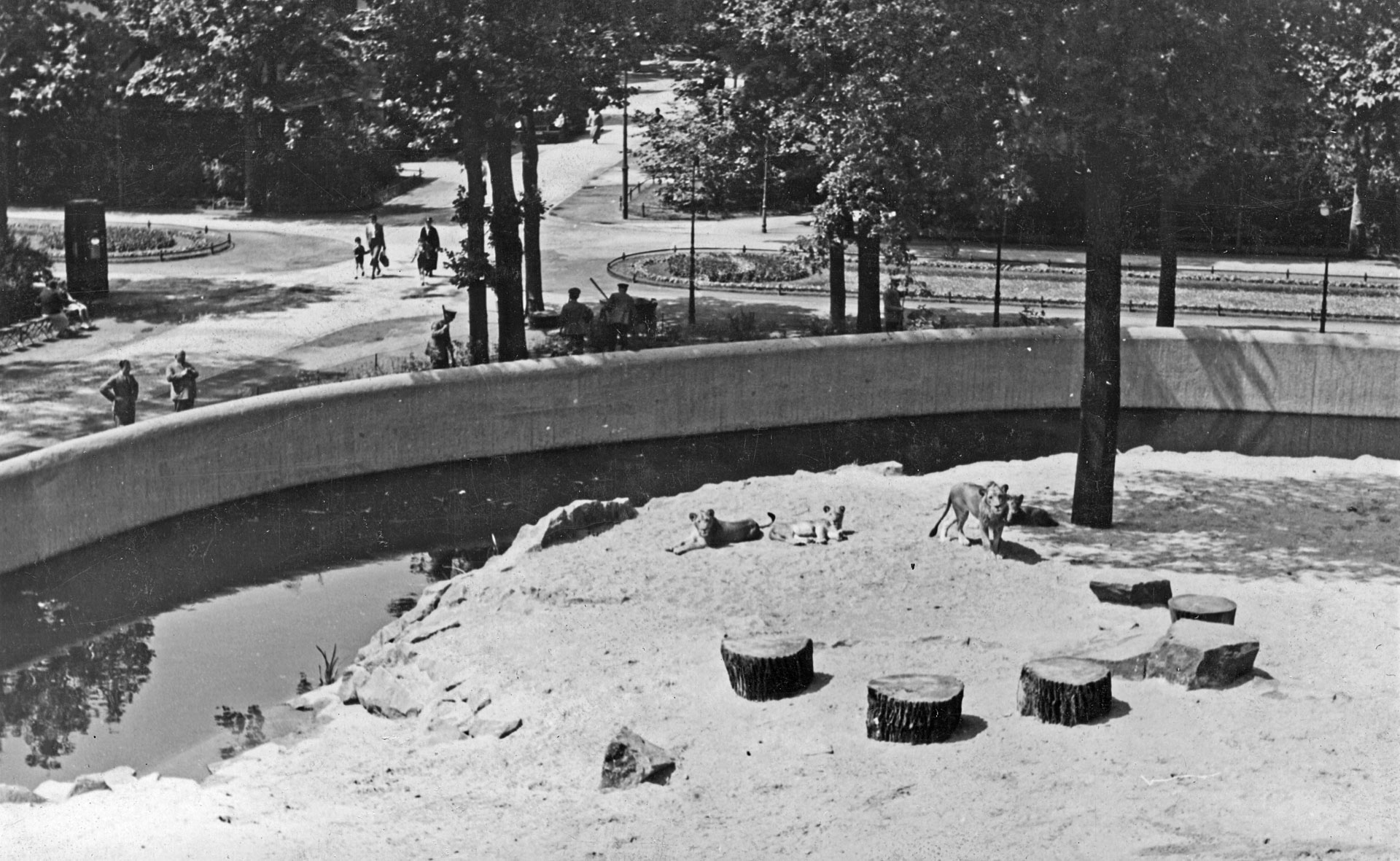
»Beyond the lions, tigers and bears, it’s zoos’ facility to reflect our own humanity that makes them such wondrous places«
Berlin's Zoological Garden lion enclosure in 1938‚ separating big cats and humans via a moat. (Photo © Berlin Zoo)
-
At the Bronx Zoo, the American architects Heins and LaFarge created a stately entrance with dozens of large bronze animals to welcome the visitor and animal houses were both more generous and more open. The Tierpark in Berlin is said to have been the first zoo to separate animals from humans with water filled moats instead of fences, giving a greater sense of exposure to the animals; and Whipsnade Zoo, founded for the conservation of animals and their habitats, is a large wildlife reserve where many of the animals are allowed to roam relatively freely in a larger enclosure.
But despite their stately appearances, and humane improvements, these zoos were still primarily designed to exhibit the animals as curiosities and their architecture reflected the status of each city or state rather than the character of the animals enclosed within. Early shifts in this thinking presented themselves in the middle to latter half of the twentieth century in projects like the Penguin Pool (1934), and the Snowden Aviary (1964) both at London Zoo. Berthold Lubetkin’s Penguin Pool there is one of the most celebrated pieces of architecture built by humans for animals. Featuring a modernist double helix slide for the penguins, who were usually photographed waddling down the winding slope, Lubetkin’s creation is a naive marriage between naked formalism and a romanticised version of an animal habitat. The reality was not successful. After renovation in 1987 it became a water feature and the penguins were moved to a more natural habitat
Lord Snowdon, Cedric Price and Frank Newby’s extraordinary aviary at the same zoo, built 30 years later, also attempted to be aesthetically pleasing to humans and acceptable to birds, and was designed so that both humans and birds could at times occupy the same space. Unfortunately, as with the penguin’s slide, the aviary was both difficult to construct and proved a challenge to maintain.
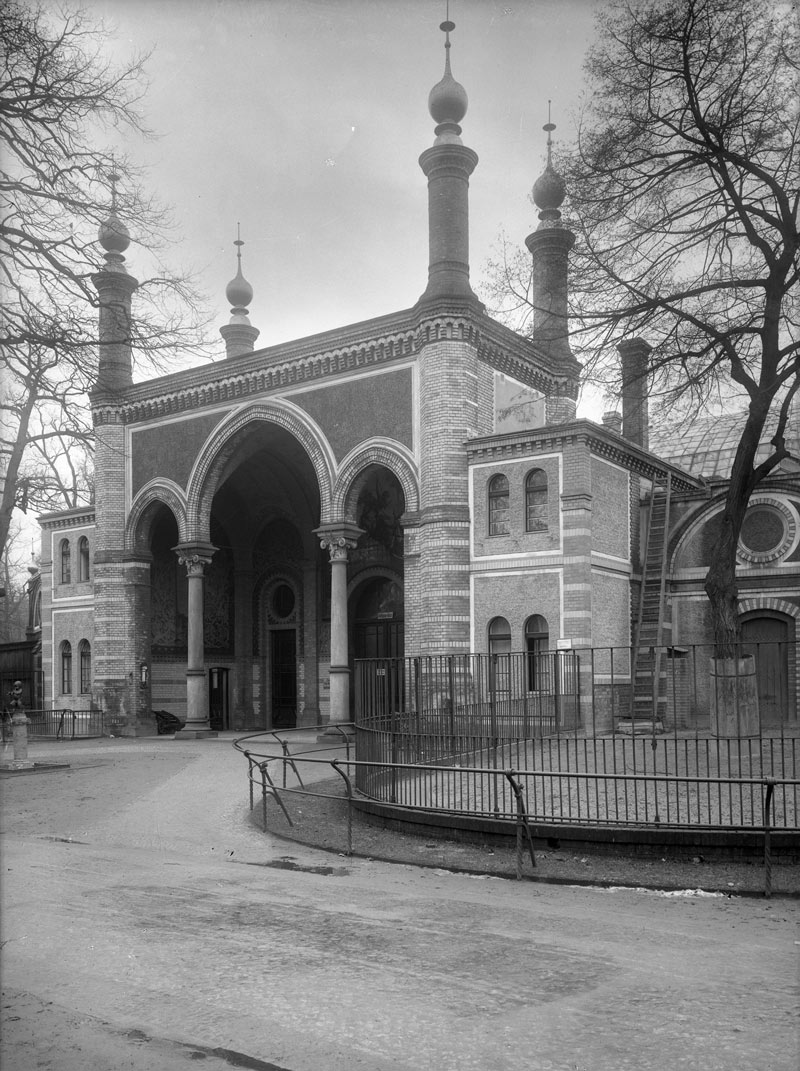
The Antelope House at Berlin Zoological Garden from 1872, designed by Hermann Ende. (Photo © Berlin Zoo)
-
»It is still JUST a one-way experience of some animals looking at some other animals«
Lord Snowdon, Cedric Price and Frank Newby’s aviary at London Zoo, built in 1964. (Photo © ZSL)
-
Mutualism, naturalism and immersion: late modern zoo enclosures
Towards the end of the twentieth century, zoos became increasingly immersive. The visible construction of animal houses took a back seat to the re-creation and presentation of faux-natural habitats. In contrast to Lubetkin’s or Price’s stark forms, zoo buildings became increasingly camouflaged and integrated with animals, visitors and landscape alike. Bernard Tschumi’s Giraffe Pavilion in the Paris Zoo (part of his 2009 redesign of the entire site), for example, blends environment, fencing and structure into one habitat, creating a statement of synthesis and mutualism without being phoney.
The French architecture firm of Beckman N’Thépé with TN Plus created proposals for the Paris, Helsinki and St. Petersburg, in 2005-6, 2007 and 2010 respectively, for quasi-natural environment renovations where they conceived of the zoo as a total environment within which the visitor becomes immersed and surround by wildness. Similar in a sense to the earlier example of Whipsnade Park, the introduction of the visitor into the animal habitat creates a sense of exposure along with a little frisson of danger and exposure to this animal world.
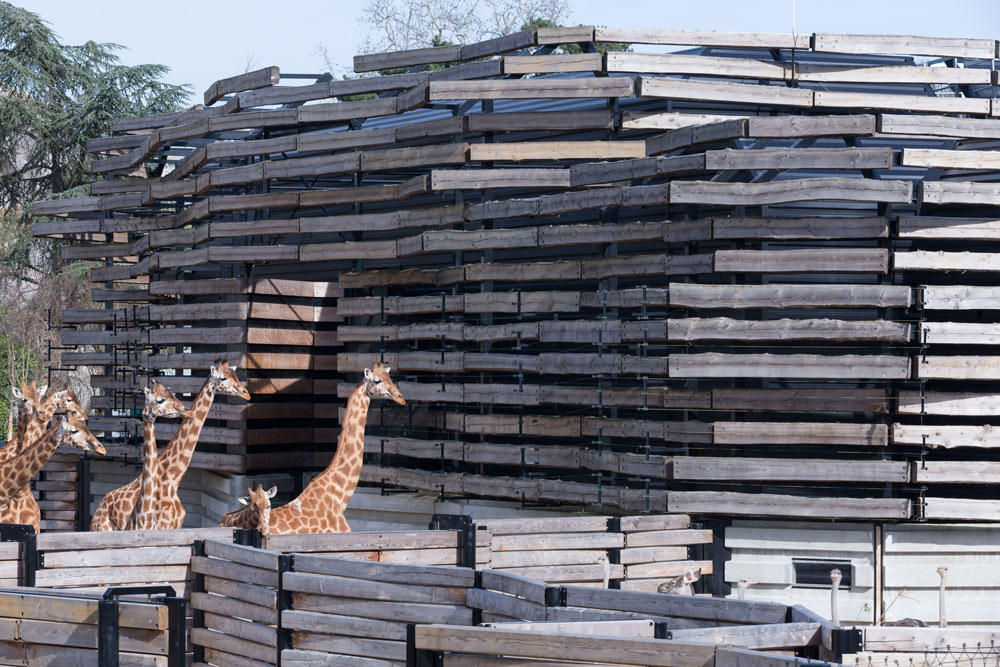
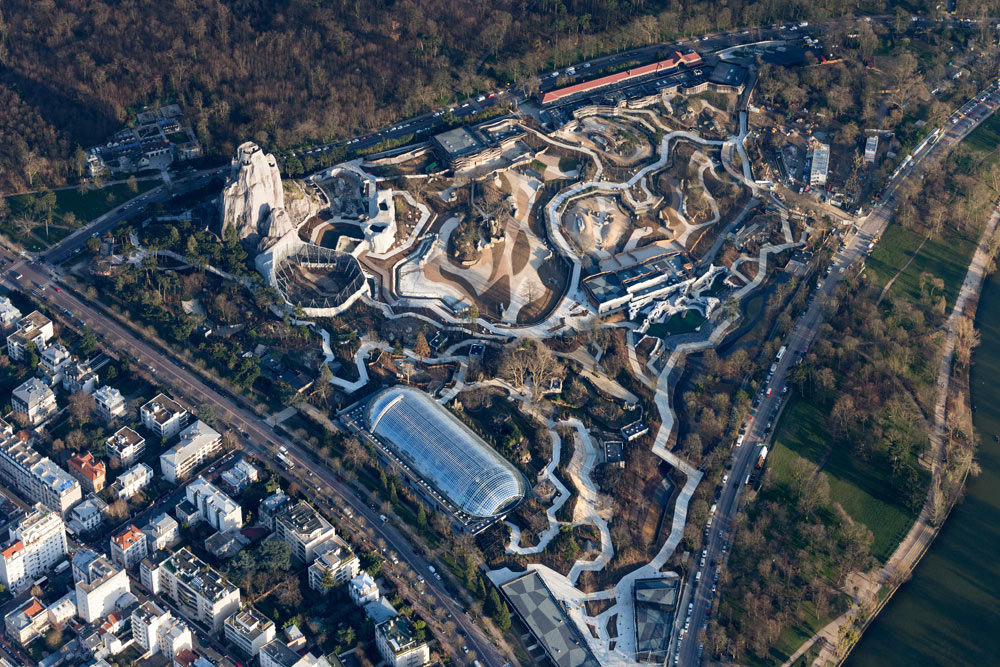
Bernard Tschumi’s plan for Paris Zoological Park treats the site as a collection of “formless” structures. The enclosure housing giraffes, antelopes and ostriches features a wooden filter system‚ designed to give the impression of a vertical landscape. (Photo © Iwan Baan, courtesy Bernard Tschumi Architects)
-
Some animals feeding some other animals at a UK safari park. (Photo: Wikicommons/Robek, CC BY 2.5)
-
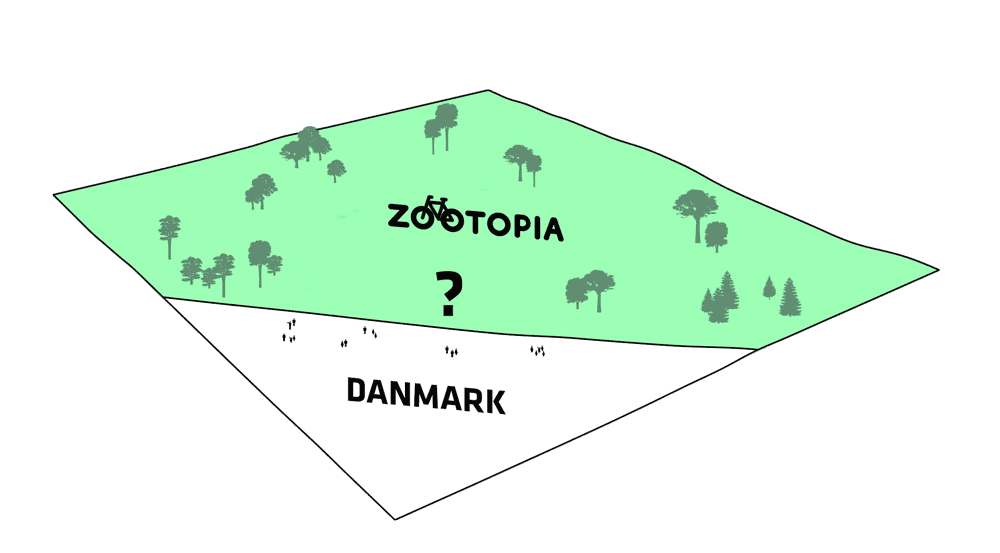
Likewise the Danish architectural team BIG has recently published proposals for Zoopolis, a futuristic model for Givskud Zoo in Denmark. Here the visitors are invited to wander among the animals in small glass pods like a contemporary Jurassic Park…which has slightly worrying implications. But though the architectural camouflage might initially distract or fool the animal and observer into a perception of proximity the clear line between the animal and the human worlds remains – just as it was with Whipsnade’s wall-less safari park of the 1930s. Be it jeeps and cars or glass tubes and floating pods, all continue to reinforce anthropocentric views and objectify the animal life within. It's still a one-way experience of some (humanoid) animals looking at some other (non-humanoid) animals.
BIG’s 2014 Zootopia plan for Givskud Zoo in Denmark aims to create the “freest possible” environment for both animals and their visitors. (Diagrams courtesy BIG)
-
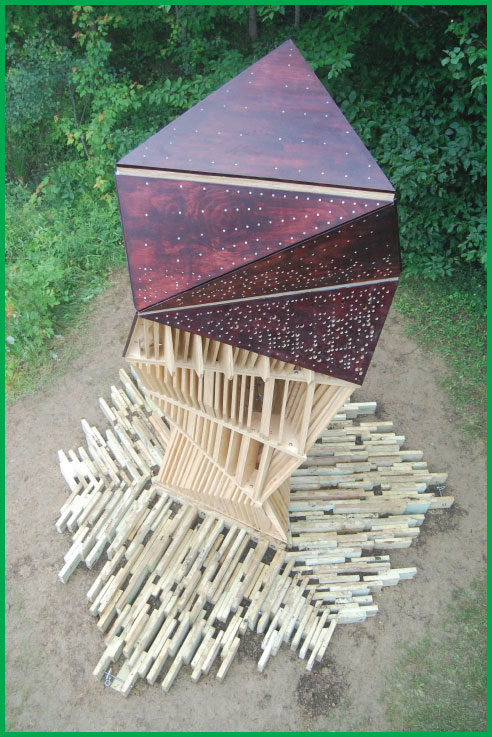
Immersion, othering and inverted species dynamics: a radical shift in species-thinking
Within the last ten years there has been an explosive resurgence in interest in the lives, thoughts, and status of non-human animals. Studies in the fields of biology, ethology and the humanities have tended towards what has been termed Post-Human or Animal Studies, the effects of which are being expressed in a number of projective and sometimes small-scale alternative zoo proposals.
Currently a growing number of designers are unwilling to merely propose a boundary-less zoo. They seek to expose underlying humanist values dominant in the zoo and to re-centre and re-empower the non-human animals within. Natalie Jeremijenko, Joyce Hwang and Fritz Haeg, for example, each push the definition of zoo into new and unexplored territories. Artist and engineer Natalie Jeremijenko, has created several species-inverting installations, one of which is titled OOZ, an inverted zoo project. With OOZ, Jeremijenko employs robotic animals and electronic devices to create an environment where it is the people on display.
Architect Joyce Hwang’s work similarly upends traditional thoughts about the roles of animals in society and the place of architecture in animal lives.
Joyce Hwang's 2010 Bat Tower (inset) at Griffis Sculpture Park‚ Ashford Hollow Foundation‚ NY and Bat Cloud installed in 2012 at Tifft Nature Preserve‚ Buffalo Museum of Science‚ NY. (Photos courtesy Joyce Hwang/Ants of the Prairie)
-
Ned Dodington is a licensed architect and designer working to develop new practices for biologically inclusive design. He is the founding editor and creative director of The Expanded Environment, a web-based investigation into the performative role of design in ecology. His design research and writings have appeared magazines such as Architectural Design and Bracket Journal and Arts and Culture, and his built work and installations have been exhibited in solo and group shows in Texas and in Minnesota. In 2013 he was named one of six emerging design leaders by The Design Futures Council.
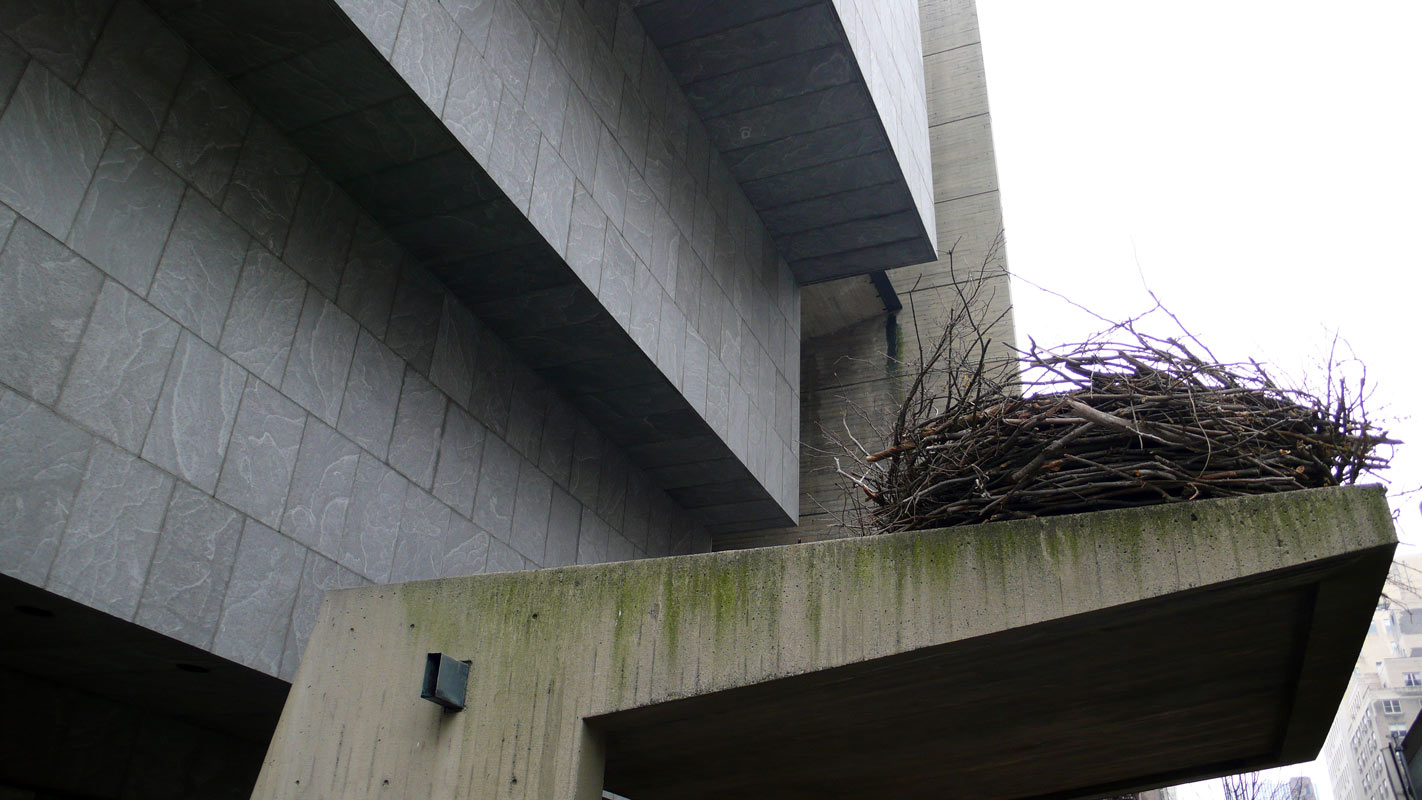
Installation view of “Animal Estates regional Model Homes #1: New York, NY”, by Fritz Haeg at the Whitney Museum of American Art, NY, 2008. (Photo: Sheldan C. Collins)
Her work with bat habitats, such as her Bat Tower and Bat Cloud demonstrate that designers can design for the particularities of an animal’s behaviour and create spaces that are integral to both human and animal life.
Finally, Fritz Haeg, an artist who also trained as an architect, is interested in eliciting interactions from the animals that are part of our daily lives. One of his more recent installations is of small animal habitats in and around the Whitney Museum in midtown Manhattan to attract and provide respite for other “Manhattan animals” such as the bald eagle, barn owl, wood duck, purple martin, eastern tiger salamander and beaver.
So while it would seem that the human desire to marvel at other animals is constant our understanding and appreciation for them is in perpetual flux. Zoos are undoubtedly enchanting and exciting places. They entertain, educate and, when done well, can humanise their visitors. But in the future, rather than at a park or a place, we might discover that we are already living within a rich, wild and boundless zoo. I
-
Search
-
FIND PRODUCTS
PRODUCT GROUP
- Building Materials
- Building Panels
- Building technology
- Façade
- Fittings
- Heating, Cooling, Ventilation
- Interior
- Roof
- Sanitary facilities
MANUFACTURER
- 3A Composites
- Alape
- Armstrong
- Caparol
- Eternit
- FSB
- Gira
- Hagemeister
- JUNG
- Kaldewei
- Lamberts
- Leicht
- Solarlux
- Steininger Designers
- Stiebel Eltron
- Velux
- Warema
- Wilkhahn
-
Follow Us
Tumblr
New and existing Tumblr users can connect with uncube and share our visual diary.
»Where there is nothing, everything is possible. Where there is architecture, nothing (else) is possible.«
Rem Koolhaas
Keyboard Shortcuts
- Supermenu
- Skip Articles
- Turn Pages
- Contents


